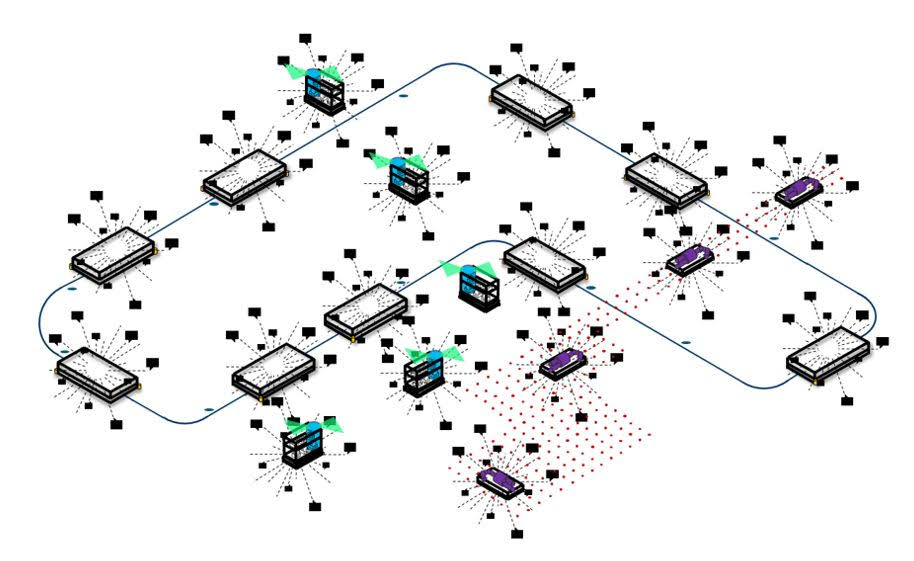
VDA5050: A Comprehensive Overview
1. What is VDA5050 and Who Develops It?
VDA5050 is a communication standard designed for industrial automation, particularly for Automated Guided Vehicles (AGVs) and Autonomous Mobile Robots (AMRs). It was developed under the leadership of the German Association of the Automotive Industry (VDA) with contributions from numerous industrial partners. The primary goal of VDA5050 is to enable AGVs and AMRs from different manufacturers to work together seamlessly in the same environment, standardizing industrial automation processes. This makes the integration and management of AGVs and AMRs in factories, warehouses, and beyond significantly easier.
While the VDA5050 documentation currently presents it as a system primarily designed for warehouses and factories, it is clear that the standard has the potential to expand into other areas. For example, although VDA5050 was initially developed for AGVs, it now also supports AMRs, demonstrating its adaptability and scalability. This flexibility suggests that VDA5050 could soon be applied in a variety of environments, such as restaurants, cafes, hotels, and even residential settings. As the standard continues to evolve, its scope is likely to grow, making it a versatile solution for a wide range of automation needs.
2. Differences Between VDA5050 and Other Fleet Management Systems
Below is a comparison table highlighting the key differences between VDA5050, OpenRMF, and MassRobotics Interop:
| Feature/Aspect | VDA5050 | OpenRMF | MassRobotics Interop |
|---|---|---|---|
| Development | Developed by multiple industrial partners under VDA. | Developed as an open-source project, primarily ROS-based. | Developed by MassRobotics, with open-source contributions. |
| Compatibility | Works with any AGV manufacturer. | Limited to ROS-compatible robots. | Requires specific adaptations for different robots. |
| Ease of Implementation | Clear and detailed documentation; easy to implement. | Requires ROS expertise; limited to ROS ecosystems. | Documentation can be complex; implementation varies. |
| Industrial Focus | Designed for real-world industrial scenarios. | More suited for research and development environments. | Focuses on interoperability but lacks industrial depth. |
| Scalability | Highly scalable for large industrial deployments. | Limited scalability due to ROS dependency. | Moderate scalability, but not as robust as VDA5050. |
| Adoption | Widely adopted in the automotive and logistics industries. | Primarily used in academic and research settings. | Limited adoption in industrial settings. |
3. Advantages of VDA5050: Why is it Superior?
VDA5050 stands out due to its ability to address real industrial needs directly. Unlike other systems, VDA5050 is developed with contributions from multiple industrial partners, making it highly practical for real-world applications. For example:
- OpenRMF is limited to ROS-based systems, which not all robot manufacturers support.
- MassRobotics Interop suffers from implementation complexity and lacks the industrial depth of VDA5050.
Additionally, VDA5050’s documentation is clear and detailed, making it accessible to anyone who wants to implement the standard. In contrast, MassRobotics Interop often lacks comprehensive documentation, and OpenRMF requires ROS expertise, limiting its usability.
4. VDA5050 and the Ecosystem of Fleet Managers
VDA5050 is not just a standard; it is supported by a growing ecosystem of fleet managers and companies that develop VDA5050-compliant solutions. This ecosystem ensures that the standard remains versatile and adaptable to various industrial needs. In contrast, other interfaces like OpenRMF and MassRobotics Interop lack the same level of commercial support and productization.
VDA5050 Ecosystem
The VDA5050 ecosystem includes several companies that have developed productized, saleable fleet management solutions. These solutions are ready for deployment in industrial environments and are backed by professional support and continuous development.
Comparison with Other Interfaces
- OpenRMF: Unlike VDA5050, OpenRMF does not have a productized, saleable version offered by any major company. It is primarily an open-source project focused on ROS-based systems, which limits its adoption in industrial settings. While it is useful for research and development, it lacks the commercial backing and professional support needed for large-scale industrial deployments.
- MassRobotics Interop: MassRobotics Interop is another open-source initiative aimed at improving interoperability. However, it also lacks a productized, commercially supported version. Its adoption is limited to specific use cases, and it does not have the same level of industrial support as VDA5050.
Why This Matters
The availability of productized, saleable solutions is a significant advantage for VDA5050. Companies looking to implement AGV fleets need reliable, supported solutions that can be deployed quickly and scaled efficiently. VDA5050’s ecosystem provides this, while other interfaces like OpenRMF and MassRobotics Interop remain largely experimental or niche, limiting their practicality in real-world industrial environments.
5. Conclusion and Evaluation
VDA5050 has established itself as a critical standard in industrial automation and AGV management. Compared to other fleet management systems, its real-world applicability, ease of implementation, and strong industrial backing make it a superior choice. However, the Germans’ tendency to create complex rules and regulations could impact its future adoption. If the standards remain practical and not overly restrictive, VDA5050 is undoubtedly set to lead the industry in the coming years.